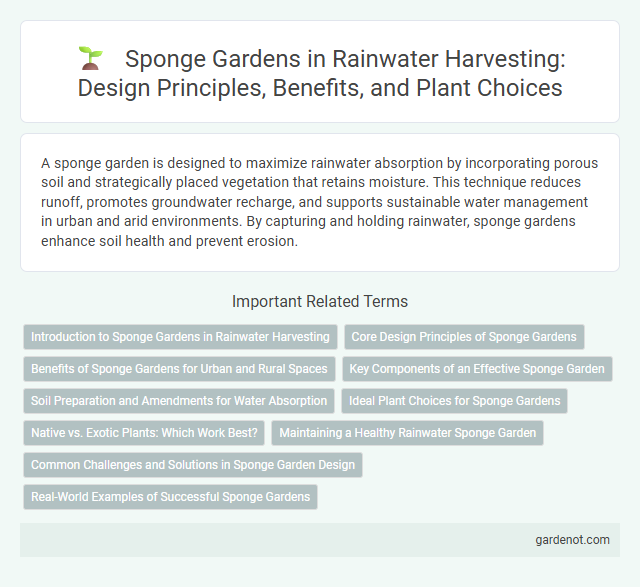A sponge garden is designed to maximize rainwater absorption by incorporating porous soil and strategically placed vegetation that retains moisture. This technique reduces runoff, promotes groundwater recharge, and supports sustainable water management in urban and arid environments. By capturing and holding rainwater, sponge gardens enhance soil health and prevent erosion.
Introduction to Sponge Gardens in Rainwater Harvesting
Sponge gardens serve as innovative rainwater harvesting systems designed to capture, absorb, and slowly release stormwater into the ground, reducing runoff and improving groundwater recharge. These gardens use porous soils, organic mulch, and native plants with deep root systems to enhance water infiltration and retention. Implementing sponge gardens can significantly mitigate urban flooding and promote sustainable water management by mimicking natural hydrological processes.
Core Design Principles of Sponge Gardens
Sponge gardens utilize permeable surfaces, native vegetation, and contour-based landscaping to enhance rainwater infiltration and reduce runoff. Key design principles include maximizing water retention through soil amendments and strategic placement of plants with high absorption capacity. These elements work together to create resilient urban green spaces that mitigate flooding and improve groundwater recharge.
Benefits of Sponge Gardens for Urban and Rural Spaces
Sponge gardens enhance urban and rural spaces by improving rainwater absorption and reducing runoff, which helps prevent flooding and replenishes groundwater supplies. These gardens increase biodiversity by supporting native plants and pollinators, contributing to healthier ecosystems. Furthermore, sponge gardens mitigate urban heat islands and improve air quality, creating more sustainable and resilient environments.
Key Components of an Effective Sponge Garden
An effective sponge garden incorporates permeable soil, native plants with deep root systems, and strategically placed rainwater collection areas to maximize water infiltration and retention. Key components include rain gardens, bioswales, and mulch layers that reduce runoff and promote groundwater recharge. Proper grading and soil amendments enhance the garden's capacity to absorb and filter rainwater, supporting sustainable urban water management.
Soil Preparation and Amendments for Water Absorption
Soil preparation for a sponge garden involves loosening compacted soil to enhance permeability and prevent runoff, using tools like garden forks or tillers. Incorporating organic amendments such as compost, mulch, and biochar significantly improves soil structure, increases porosity, and boosts the soil's water retention capacity. These practices optimize water absorption, allowing harvested rainwater to infiltrate effectively, support plant growth, and reduce erosion.
Ideal Plant Choices for Sponge Gardens
Ideal plant choices for sponge gardens include native species with high water absorption and retention capabilities, such as sedges, rushes, and ferns. These plants thrive in moist, well-drained soil while enhancing rainwater infiltration and reducing runoff. Incorporating deep-rooted perennials like switchgrass and blue flag iris further supports sponge garden effectiveness by stabilizing soil and improving water capture.
Native vs. Exotic Plants: Which Work Best?
Sponge gardens thrive by using native plants that are adapted to local rainfall patterns and soil conditions, enhancing water absorption and reducing runoff more effectively than exotic species. Native plants' deep root systems improve soil structure and increase infiltration rates, making them ideal for maximizing rainwater capture in sponge gardens. Exotic plants often require more water and maintenance, potentially undermining the sustainability goals of rainwater harvesting systems.
Maintaining a Healthy Rainwater Sponge Garden
Maintaining a healthy rainwater sponge garden involves regular monitoring of soil moisture levels to ensure optimal water retention and prevent oversaturation. Incorporating native, drought-resistant plants enhances water absorption and filtration, promoting a balanced ecosystem within the garden. Periodic inspection and removal of debris support effective rainwater infiltration, sustaining the sponge garden's efficiency in managing stormwater runoff.
Common Challenges and Solutions in Sponge Garden Design
Sponge gardens often face challenges such as poor soil infiltration, uneven water distribution, and root clogging, which reduce rainwater absorption efficiency. Implementing layered soil composition with organic matter, utilizing permeable substrates, and designing contour-based layouts can enhance water retention and minimize runoff. Regular maintenance, including sediment removal and vegetation management, ensures sustained performance of sponge garden systems in urban water management.
Real-World Examples of Successful Sponge Gardens
Sponge gardens effectively manage stormwater by absorbing rainwater to reduce runoff and promote groundwater recharge, as seen in Singapore's Bishan-Ang Mo Kio Park, where naturalized riverbanks have significantly decreased flooding. In Portland, Oregon, neighborhood sponge gardens with native plants have lowered urban heat and improved water quality by filtering pollutants. These real-world implementations highlight the practicality and environmental benefits of sponge gardens in urban rainwater harvesting systems.
Sponge garden Infographic

 gardenot.com
gardenot.com